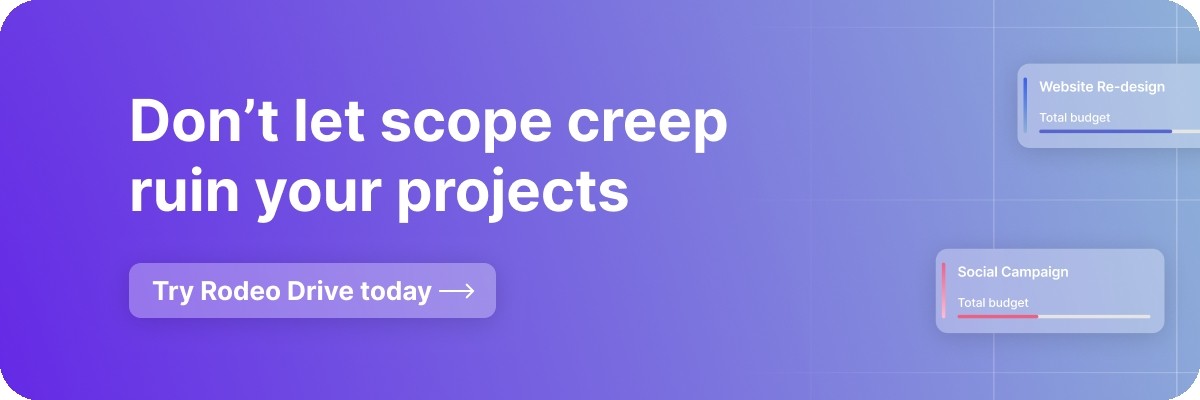Don't Let Scope Creep Ruin Your Project: Tips and Best Practices
Have you ever worked on a project that started small but became a massive undertaking? The goals and objectives you so carefully defined expanded beyond what was initially intended. Welcome to the doom and gloom of scope creep.
It can happen gradually, with slight changes adding up over time, or suddenly, with a major change that alters the entire direction of the project.
Sigh of relief — you’re not alone. A survey among project managers concluded that 92% of projects fail due to a lack of scope creep management.
In this article, we'll explore the causes of scope creep in project management, the common causes, and how to prevent it from happening in the first place. Grab a coffee and settle in – project management will never give you the creeps again.
What is scope creep in project management?
Scope creep happens when the project's scope expands beyond its original intended boundaries or objectives. It can happen when new requirements, goals, or features are added to a project by your client or manager without considering their impact on the project.
Before you and your team start executing a project, you need to solidify what you're trying to accomplish — project scope — when writing a project plan. The project scope lists the boundaries for the project by establishing what is (and isn’t) included in your objectives. To ensure everyone's on the same page, you usually write this all down in a project statement of work document.
Defining your scope early on is a must before you start working on the project. If you don't, you might end up with scope creep.
Scope creep can also occur when the project team or stakeholders fail to define clear goals and objectives at the outset of the project, allowing the project to evolve in ways that were not originally intended.
Examples of scope creep in projects
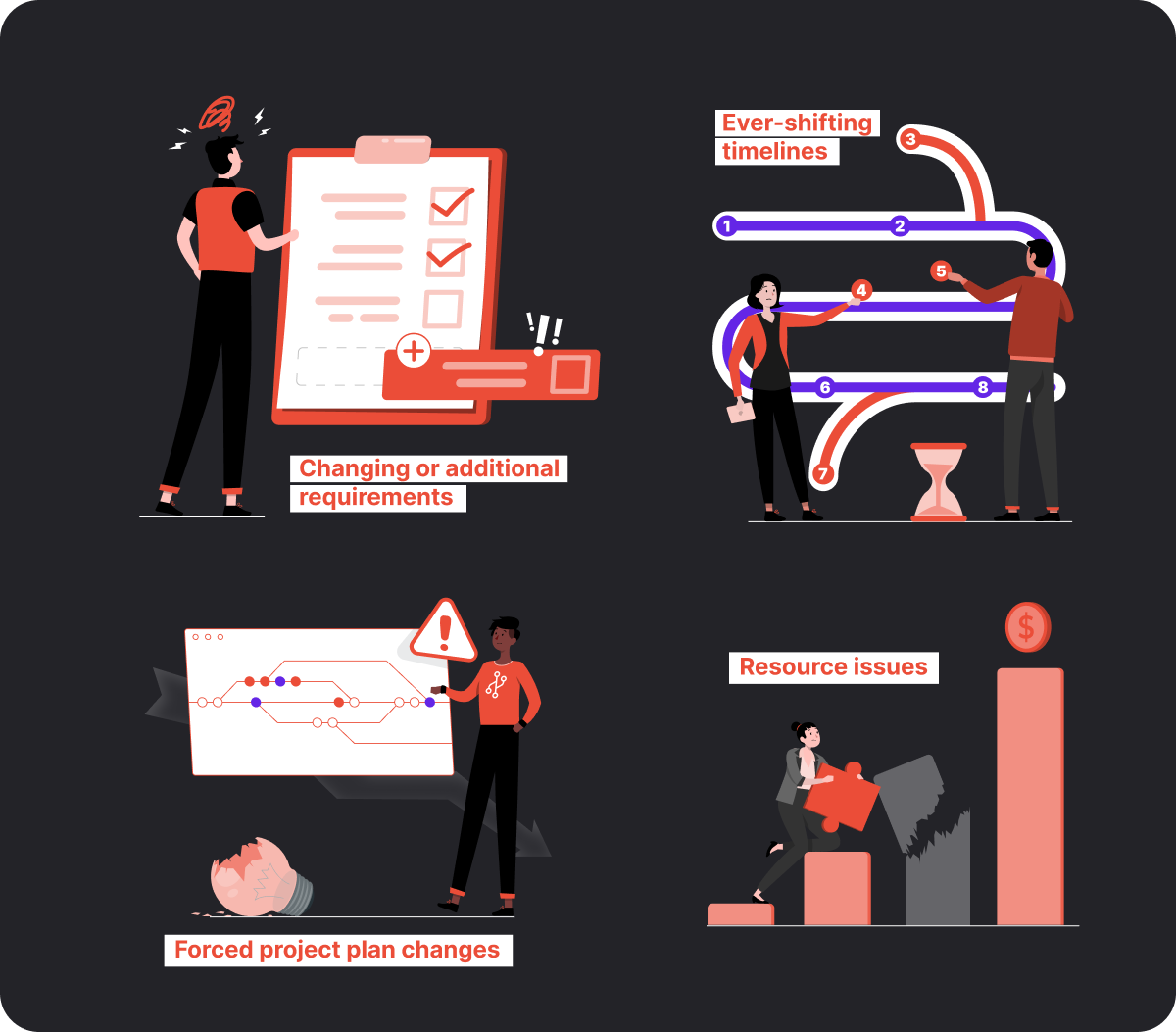
Scope creep can happen to any project, no matter its stage. This can show up in a number of different ways depending on the work you're doing.
We start with the classic changing or additional requirements: One of the most common causes of scope creep is when project stakeholders request new features or functionality that were not initially included in the scope.
For example, if you're building a website and the client suddenly decides they want a blog section, that's scope creep. These changes force the project team to rearrange resources and timelines to adapt to these unexpected shifts.
Ever-shifting timelines: Let's say you're working on a project and have set clear goals and deadlines. However, your team needs more time to finish the new designs for an extended media campaign, as requested by the client. This can be frustrating because it makes it hard to track progress, and the project starts to expand beyond its original goals.
While flexibility can be helpful, managing deadlines that are constantly changing can make it feel like the work will never be finished. Plus, if the project goals aren't clearly defined, it can be hard to know when you've achieved them.
Related: How To Build A Project Timeline: A Step By Step Guide
Your project plan is forced to change: Even when you plan for all possible scenarios, things outside your control can influence your initial project plan and budget. A thunderstorm or major traffic jam can wreak havoc on your outdoor product launch, or a severe illness in the team can halt a project entirely.
Resource issues: If a project suddenly requires additional team members, new equipment, or extra time and effort, it can strain the resources allocated. This can lead to delays, cost overruns, and other negative impacts on the project.
Plus, if the project team focuses on implementing new work that wasn't originally part of the plan, it could mean that other critical tasks are neglected or receive insufficient resources. This can ultimately harm the project's overall success. Changing your resource allocation could mean an extra budget needs to be added or the deadline shifts, which is not a great conversation to have with your client.
Common causes of project scope creep
Scope creep can take many forms in project management and can be caused by a variety of factors. From miscommunication that can derail a project’s progress to a lack of task prioritization, let’s have a closer look at these common causes.
Miscommunication
A study conducted by the Project Management Institute revealed that poor communication can negatively impact project execution.
Not surprisingly, miscommunication between the project team and stakeholders can also lead to scope creep. For example, if the project team thinks they have a clear understanding of the project requirements, but the stakeholders have a different interpretation, it can lead to changes or additions that were not originally planned.
Related: A Guide to Project Communication Management
Vague project scope
Without clear project objectives, your team may struggle to determine which tasks are most important and may end up working on tasks that do not align with the project's objectives. Scope creep can also happen when you're asked to perform work that was not originally planned. For example, if you're designing a brochure and the client asks you to create a social media campaign to promote it.
Unrealistic goals
Develop a new landing page within two working days — go! Sounds unrealistic, right?
Without alignment between the project objectives and scope at the start, the actual project tasks can become exceedingly difficult. Businesses that set realistic goals and have processes in place are more likely to meet their project goals.
Lack of task prioritization
Balancing the quality of the work, the deadline, resources, and budget is crucial. If you haven’t prioritized tasks based on the project objectives, your team members might work on tasks that don’t contribute to the project deliverables.
Team structure or hierarchy issues
As soon as the project kicks off, comments, feedback, and concerns come in from all directions. This is a classic example of too many cooks in the kitchen. If all stakeholders and team members are marked as decision-makers, you’ll be plagued with changing priorities, and you can’t drive the project forward.
Nowadays, project teams consist of 6 to 10 members in many organizations. Project managers prefer small teams because they can get more things done without any conflict or hassle.
How to handle scope changes in project management?
Your project can be impacted by unforeseen events and scope changes, which can affect various aspects such as deadlines, team performance, workflows, project budget, and resources.
These project risks should be considered and managed effectively to minimize their impact on the project. Here’s how you do it.
Scope management plan
Defining your project scope and communicating that vision with stakeholders will reduce the likelihood of scope creep. The scope management plan is a crucial component of your project plan that outlines the process for establishing and controlling the project's scope.
This document encompasses a breakdown of the work, a scope statement, and the procedure for obtaining stakeholder approval for the project's scope baseline. Before finalizing, make sure that there are no unchecked client requests.
Change management plan
Instead of sorry, ‘no’ might sometimes be the hardest word for stakeholders to hear. By having a change management plan in place, you can establish a formalized procedure to approve or reject proposed changes. This ensures that you can assess any modifications to the project scope, timeline, or budget to minimize any potential negative impact.
Project progress reports can help the project manager to align with the original project scope. This project progress report typically includes updates on the project timeline, completed tasks, budget status, as well as any risks or obstacles that your team has encountered. Your stakeholders will likely think twice about adding more to your workload if they see the project is moving forward seamlessly.
Pro tip: Some projects might benefit from having a change control board in place to assess the impact and necessity of proposed changes.
Risk management plan
The project's risk management plan outlines the strategies, roles, responsibilities, and funding for managing risks. It is a comprehensive plan that contains all the necessary information to prevent and mitigate risks such as scope creep, and it’s likely your last resort after you consulted your scope management — and change management plan first.
Common risk responses include changing the project direction to avoid the risk, transferring the risk to another party, mitigating it, or accepting the risk and managing its consequences.
Also read: Navigating Uncertainty: The Importance of a Contingency Plan in Project Management
8 tips to prevent scope creep
Effectively managing scope creep requires a meticulous process, but it’s worth it since your team can stick to the agreed deadlines and deliver high-quality output, leading to more business.
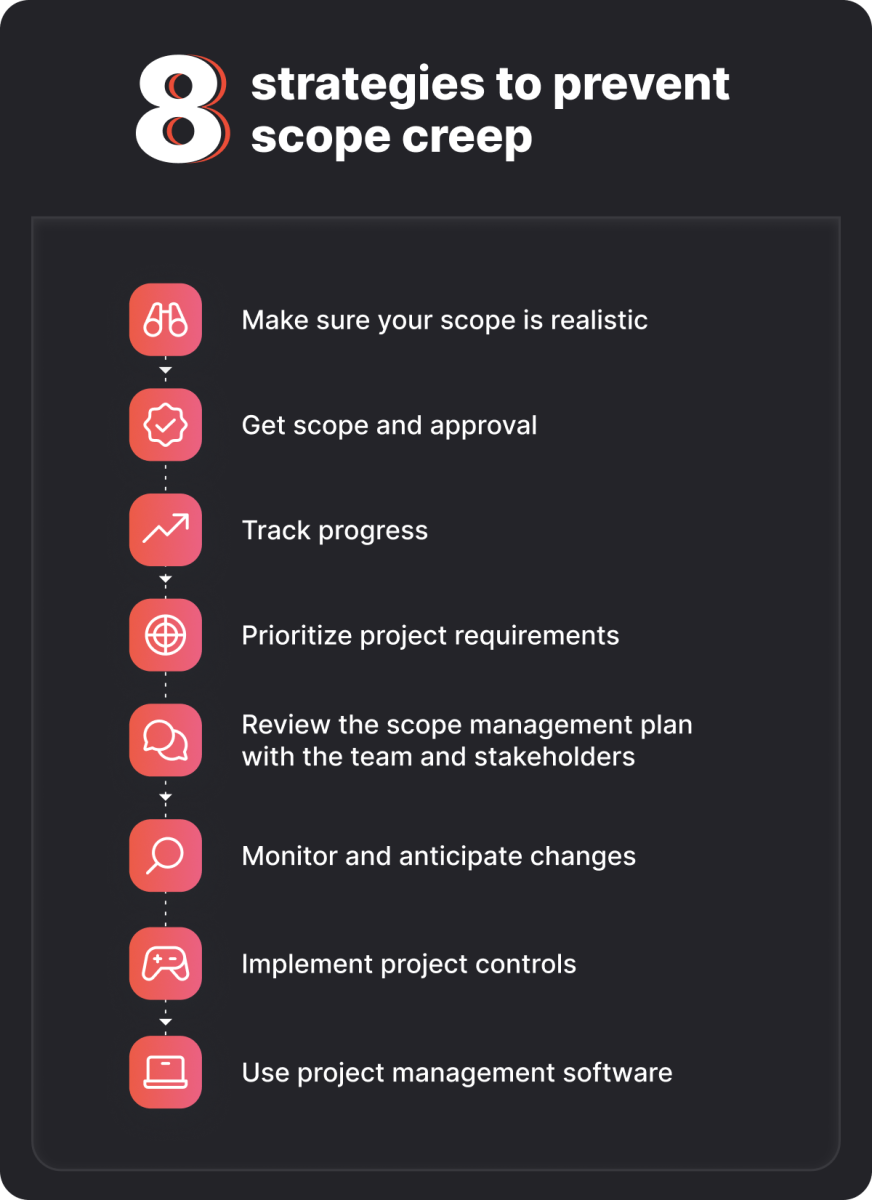
1. Make sure your scope is realistic
When it comes to preventing scope creep, the proof is in the planning. Proper and strategic planning is essential for the success of any project, regardless of its size and scope.
When you plan a project, you establish clear objectives, define the tasks required to achieve those objectives, and determine the resources and timelines needed to complete each task. Make sure to ask your team for their availability and input at this stage.
Although this might sound logical and simple, to better understand the scope of your project and what is required to achieve your final goal, it is essential to develop measurable objectives. By setting these objectives, you can gain a better understanding of the specific tasks that need to be completed.
2. Get scope approval
Ensure that your project scope is well-defined and agreed upon by all parties involved, including the client and internal or external stakeholders. Once the scope has been verbally agreed upon, it should be documented in a scope statement that outlines the project's elements, requirements, and assumptions.
Putting the scope in writing serves as a reference for the team throughout the project's duration. It can guide decision-making and measure success. Trust your instinct: if you feel it coming, get ready to re-align the requirements by using the signed-off document.
Pro tip: Charts and diagrams help make your project plan easier to digest. Rodeo Drive’s planning, budgeting, and reporting features help you better visualize the project progress and understand how close you are to completion when your team is underway.
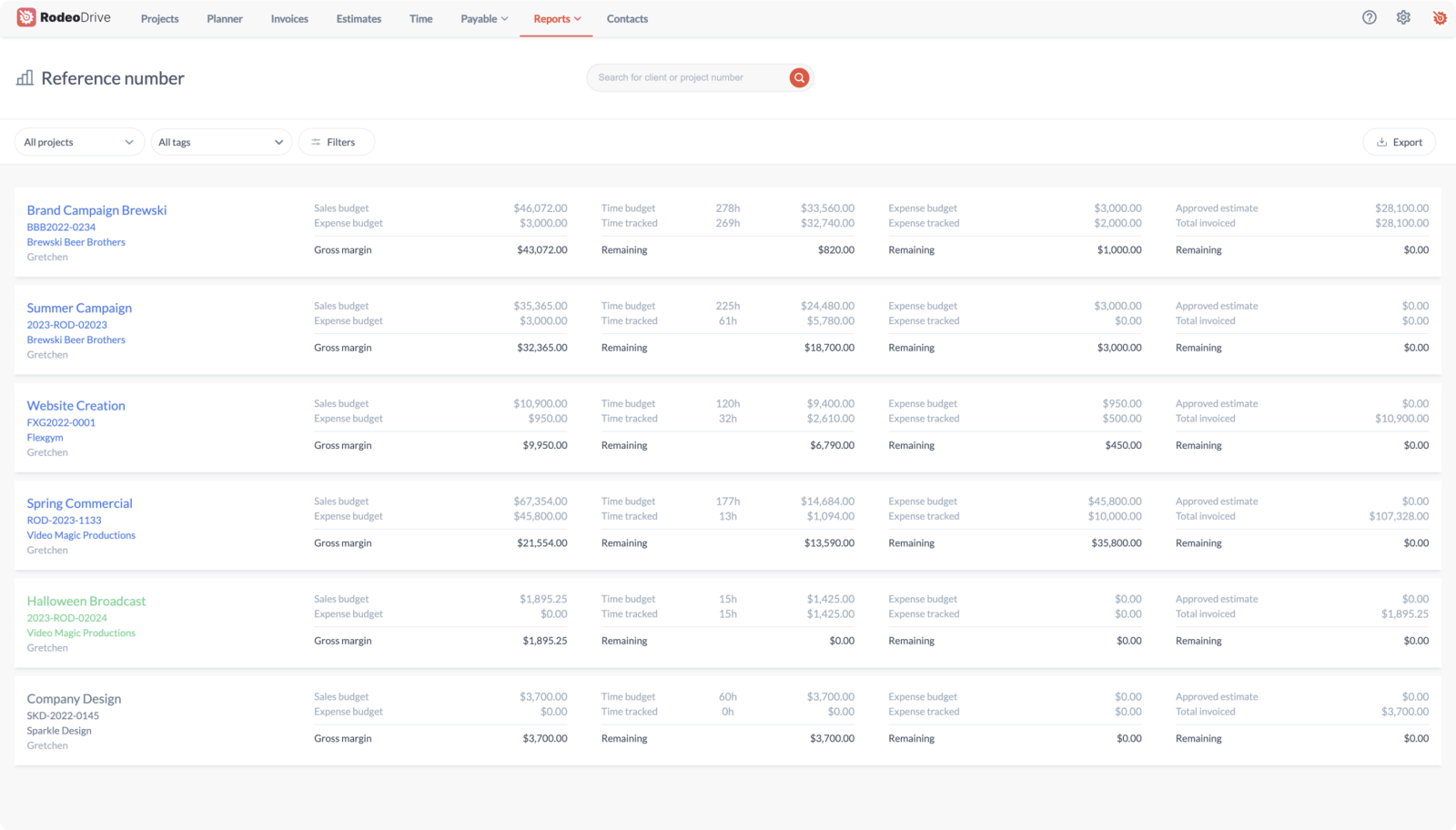
3. Track progress
It can be difficult to keep track of everything, but this process is essential to avoid your project steering off track. Discrepancies between the actual progress of a project and its planned timeline are a given in project management.
To address this, project managers need to closely monitor project progress to identify bottlenecks or scope creep that are eating up precious working hours. Shifting timelines can cause frustration with your team and moving deadlines will impact the client relationship.
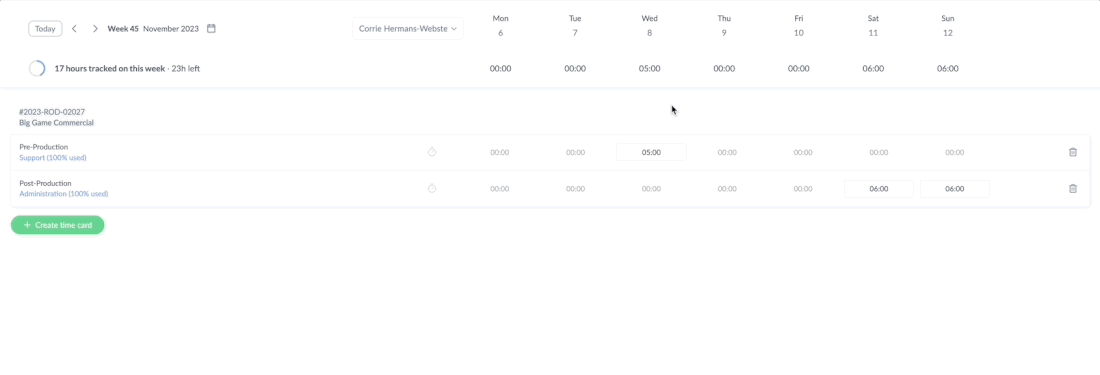
Make your life as a project manager easier and benefit from a time-tracking tool to identify if the hours allocated are correct or need adjusting.
You can initiate regular project progress check-ins and standup meetings and use visual tools like Kanban boards and timeline charts. Rodeo Drive’s planner feature shows task assignments and offers a timeline view so you can quickly understand where your project is at.
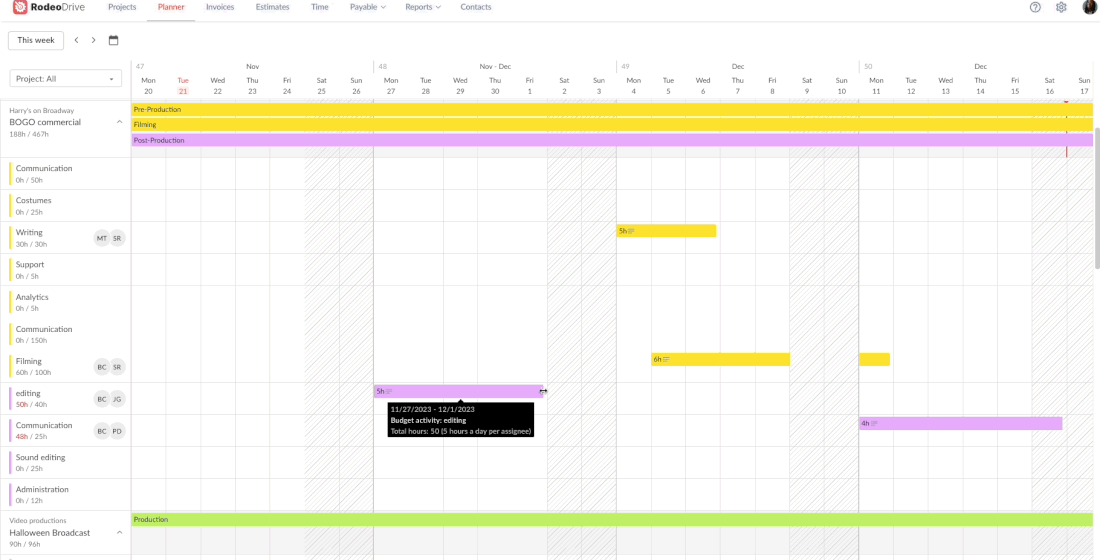
You might want to share a project progress report with your stakeholders or get a detailed overview of the progress so you can optimize the workload for the next project phase. Rodeo Drive’s reports keep you updated on the hours each team member is recording, how well they spend their time, the actual costs compared to the budget, and the project's overall profitability.
You can easily send these reports to your stakeholders for a quick overview of the project status, export your data, or invite them as a guest to collaborate and follow along as the project progresses.
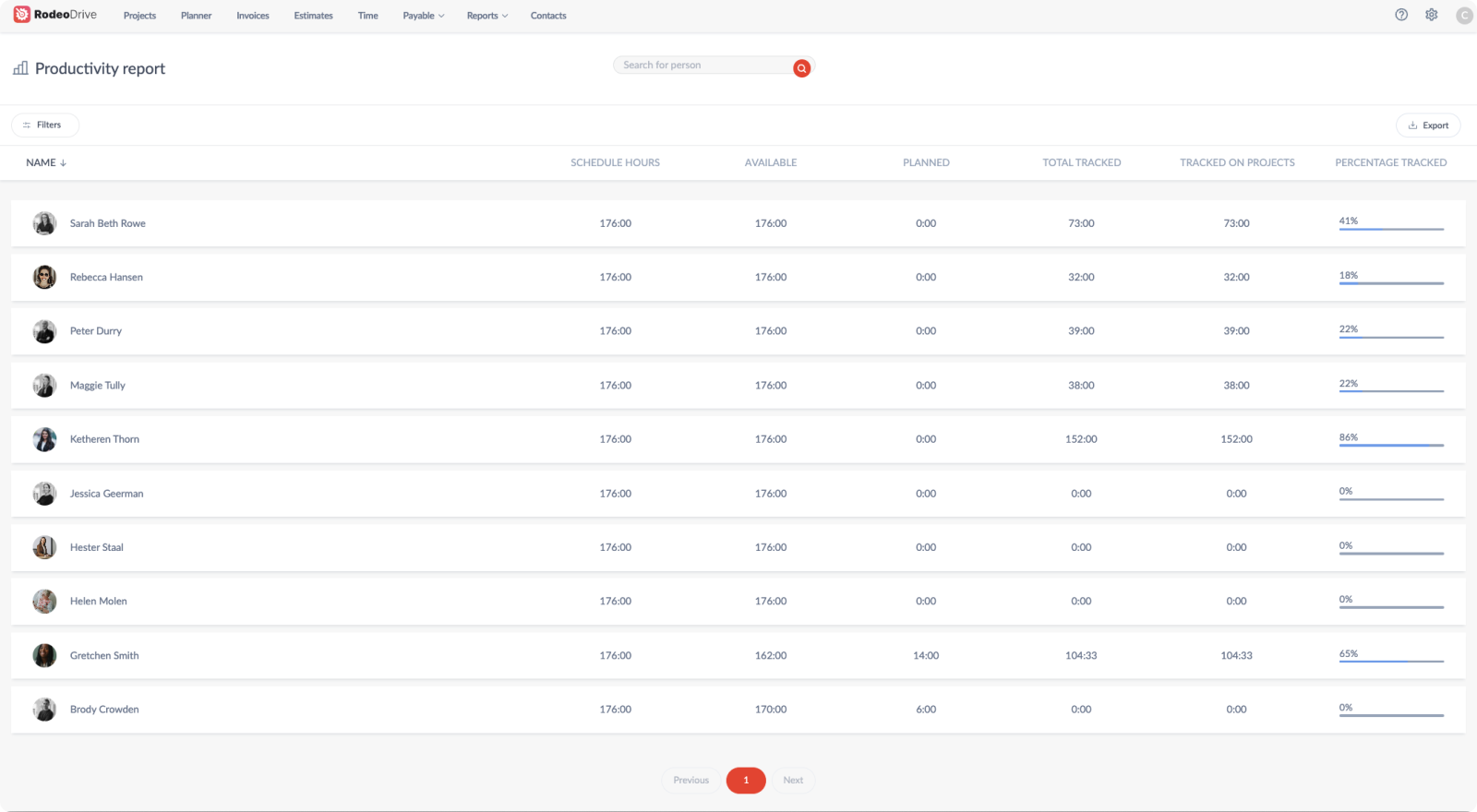
4. Prioritize project requirements
To ensure a successful project, it is essential to start with a clear understanding of the project requirements and budget and stick to them. To reach a consensus before the project gets underway, it’s recommended to present a Work Breakdown Structure (WBS).
A WBS is a visual representation of a project's hierarchical structure, task relationships, and milestones. It helps project managers and stakeholders to understand dependencies and interdependencies, break large projects into smaller components, and detail project requirements such as cost and resource estimates.
If the scope of the project needs to change, it is important to prioritize changes suggested by stakeholders with decision-making authority to ensure that the project requirements are met and the project is successful.
5. Review the scope management plan with the team and stakeholders
Invest some time to get the scope management plan right to avoid changes at a later stage.
Ensure that stakeholders and your team understand the project's scope baseline and how changes can impact the overall project management plan.
6. Monitor and anticipate changes
The probability and impact of risks may vary, and new risks can emerge while others may reduce in significance. By conducting frequent monitoring, you can identify potential risks early and take proactive measures to mitigate them, ultimately contributing to a successful project outcome.
Software with built-in reports can help you keep tabs on all the moving parts of your project. Another advantage is that you can send your client or stakeholders detailed updates without having to skim through loads of files and data to find something relevant enough to mention.
Rodeo Drive’s reports will provide unique metrics on the progress of your project, from your project profitability to an overview of time spent on every task.
7. Implement project controls
Project managers are responsible for multiple roles, including leading the team and coordinating with clients and stakeholders to ensure everyone is on the same page.
On top of that, if scope creep arises, it is their responsibility to decide how to address it.
The perfect seamless project doesn’t exist but by implementing project controls, you can quickly pinpoint budget issues that are hurting your project progress. Project controllers serve as advisors to project managers by monitoring ongoing projects and analyzing data to predict and resolve issues.
While project controllers and project managers have distinct roles, it is not uncommon for project managers to also take on project control responsibilities, particularly in small teams where a designated project controller is not available.
To create the best profit margin, every project starts with creating a solid budget in Rodeo Drive. Once you’ve built your budget, you’re able to send it as an estimate for your clients to approve in just a few clicks.
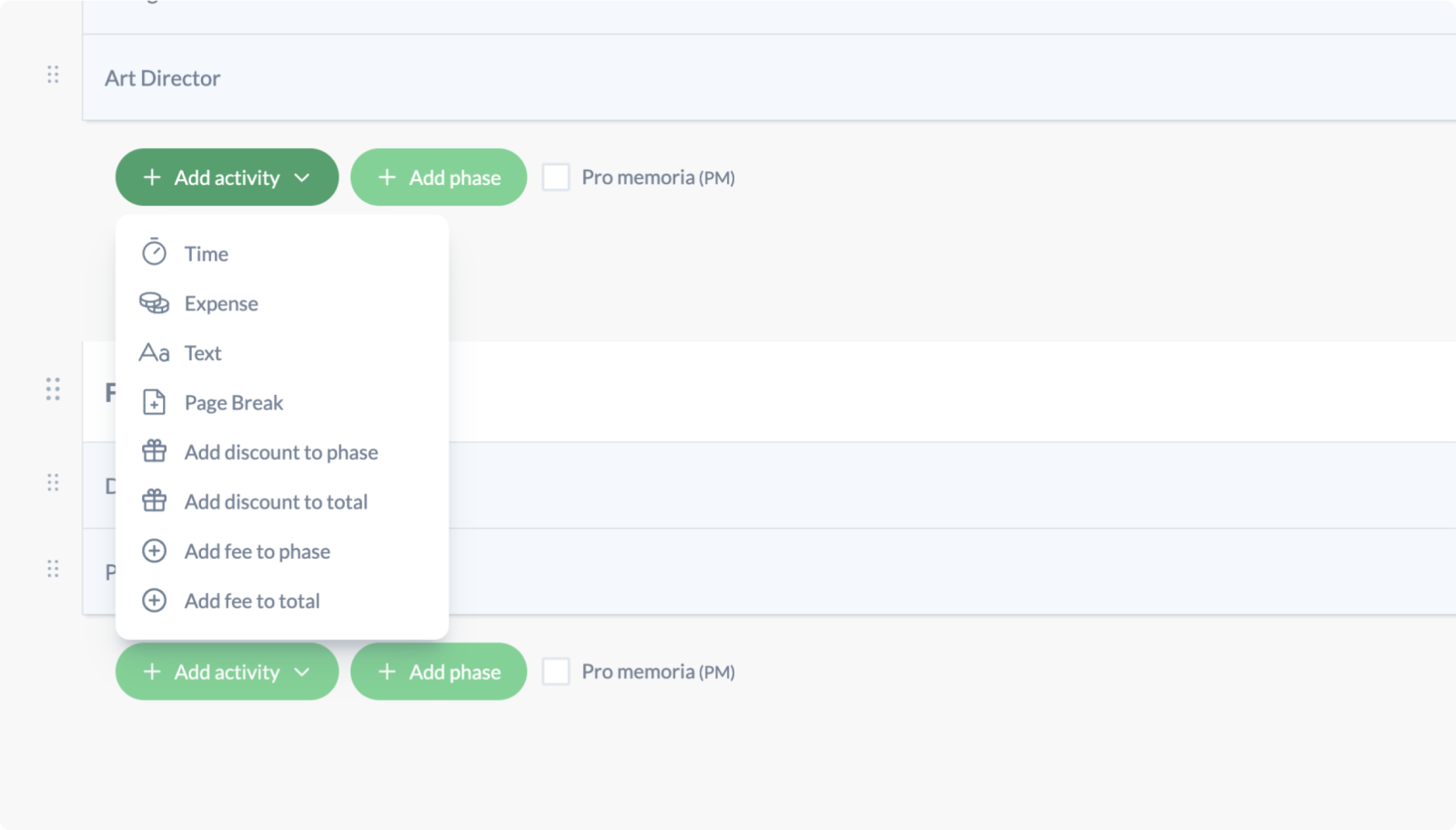
8. Use project management software
Having a centralized place to manage all your project activities helps you deliver on time and under budget. Software tools offer a range of features to keep your project organized, ranging from project planning to time tracking, and budgeting options.
It can be quite overwhelming to manage projects without the help of a software tool assisting you. There are many project management software options on the market, but which one will suit your needs? Use our guide on how to choose project management software and pick a tool that will make your life easier, not more complicated.
Avoid project scope creep with Rodeo Drive
A simple and effective way to avoid scope creep starts with managing all phases of your project's lifecycle in an all-in-one project management tool like Rodeo Drive. Our budgeting, time tracking, and reporting tools support project managers from the planning to execution and wrap-up phase.
Here are some of the additional features we have to offer:
- Send client-ready, customizable project estimates straight from the platform
- Save time by reusing budget frameworks from previous projects
- Access real-time budget updates to prevent overspending or scope creep
- Integrate with QuickBooks (US) and Xero (UK) to help with your bookkeeping
To learn more about how Rodeo Drive can improve your project progress, schedule a demo with one of our experts. Or, go ahead and start your free Rodeo Drive account today.





